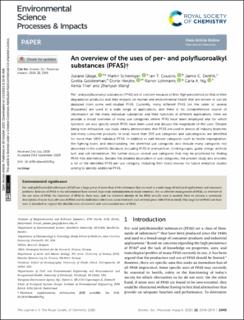| dc.contributor.author | Glüge, Juliane | |
| dc.contributor.author | Scheringer, Martin | |
| dc.contributor.author | Cousins, Ian T. | |
| dc.contributor.author | Dewitt, Jamie C. | |
| dc.contributor.author | Goldenman, Gretta | |
| dc.contributor.author | Herzke, Dorte | |
| dc.contributor.author | Lohmann, Rainer | |
| dc.contributor.author | Ng, Carla A. | |
| dc.contributor.author | Trier, Xenia | |
| dc.contributor.author | Wang, Zhanyun | |
| dc.date.accessioned | 2021-01-12T08:53:18Z | |
| dc.date.available | 2021-01-12T08:53:18Z | |
| dc.date.created | 2021-01-11T08:05:02Z | |
| dc.date.issued | 2020 | |
| dc.identifier.citation | Environmental Science: Processes & Impacts. 2020, 22, 2345-2373. | en_US |
| dc.identifier.issn | 2050-7887 | |
| dc.identifier.uri | https://hdl.handle.net/11250/2722465 | |
| dc.description.abstract | Per- and polyfluoroalkyl substances (PFAS) are of concern because of their high persistence (or that of their degradation products) and their impacts on human and environmental health that are known or can be deduced from some well-studied PFAS. Currently, many different PFAS (on the order of several thousands) are used in a wide range of applications, and there is no comprehensive source of information on the many individual substances and their functions in different applications. Here we provide a broad overview of many use categories where PFAS have been employed and for which function; we also specify which PFAS have been used and discuss the magnitude of the uses. Despite being non-exhaustive, our study clearly demonstrates that PFAS are used in almost all industry branches and many consumer products. In total, more than 200 use categories and subcategories are identified for more than 1400 individual PFAS. In addition to well-known categories such as textile impregnation, fire-fighting foam, and electroplating, the identified use categories also include many categories not described in the scientific literature, including PFAS in ammunition, climbing ropes, guitar strings, artificial turf, and soil remediation. We further discuss several use categories that may be prioritised for finding PFAS-free alternatives. Besides the detailed description of use categories, the present study also provides a list of the identified PFAS per use category, including their exact masses for future analytical studies aiming to identify additional PFAS. | en_US |
| dc.language.iso | eng | en_US |
| dc.rights | Navngivelse-Ikkekommersiell 4.0 Internasjonal | * |
| dc.rights.uri | http://creativecommons.org/licenses/by-nc/4.0/deed.no | * |
| dc.title | An overview of the uses of per- And polyfluoroalkyl substances (PFAS) | en_US |
| dc.type | Peer reviewed | en_US |
| dc.type | Journal article | en_US |
| dc.description.version | publishedVersion | en_US |
| dc.rights.holder | This journal is © The Royal Society of Chemistry 2020 | en_US |
| dc.source.pagenumber | 2345-2373 | en_US |
| dc.source.volume | 22 | en_US |
| dc.source.journal | Environmental Science: Processes & Impacts | en_US |
| dc.source.issue | 12 | en_US |
| dc.identifier.doi | 10.1039/d0em00291g | |
| dc.identifier.cristin | 1868495 | |
| dc.relation.project | NILU: 117031 | en_US |
| dc.relation.project | Norges forskningsråd: Arctic, the herald of Chemical Substances of Environmental Concern, CleanArctic | |
| cristin.ispublished | true | |
| cristin.fulltext | original | |
| cristin.qualitycode | 1 | |

